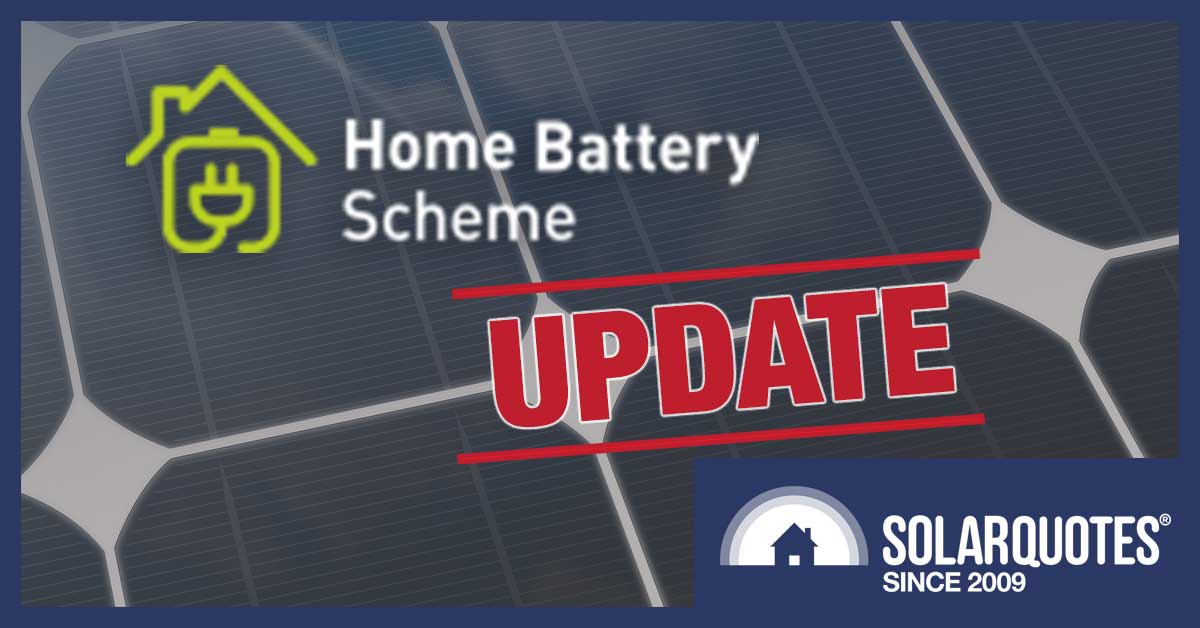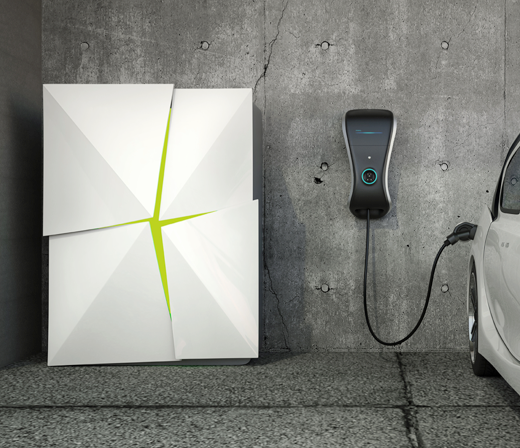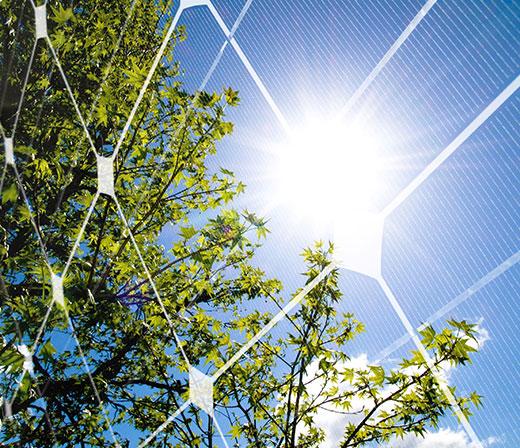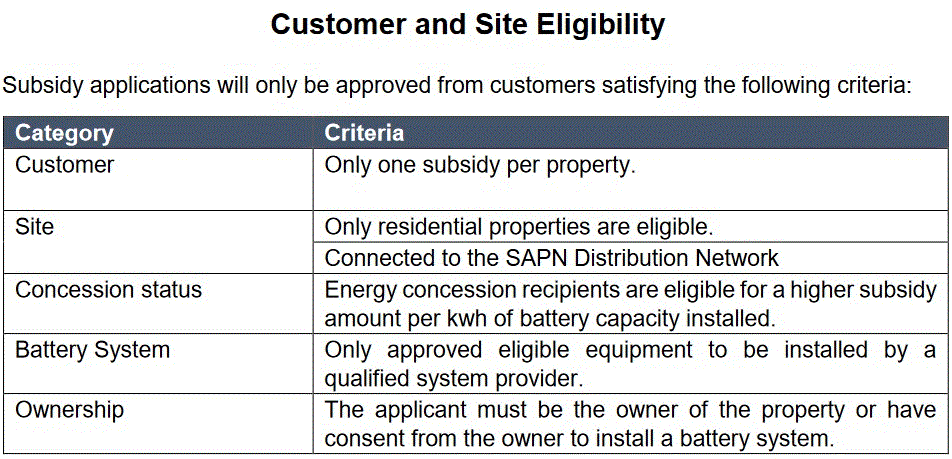
The South Australian Battery Subsidy / Rebate / Scheme Is Now Under Way – Here’s What You Need To Know
When I first wrote about South Australia’s battery subsidy not all the details were available to me. But now the Home Battery Scheme website is up and running I still don’t have all the details. However — and this is the important point — I have more details than I had before. For example, I now know the starting date. It was on Monday the 29th of October. This means if you live in South Australia you can now now get a hefty subsidy for any home battery system you like — provided you only like Sonnen batteries. You’ll have to wait until January if you want something else and remains to be seen which systems will be approved for subsidy.
If you are certain you want a subsidised Sonnen system right now, you can go to the Home Battery Scheme site and follow the follow the steps required to get one. But if you’d like a little more little information first then in this article I’ll go over the main points of the subsidy again – but I’ll also delve into some of the new details that are available.
The Subsidy Amount Has Not Changed
The amount of the subsidy hasn’t changed and for most households is:
- $500 per kilowatt-hour of capacity up to a maximum of $6,000.
While for those who receive the SA energy concession, which includes pensioners and most people receiving Centrelink payments, the subsidy is:
- $600 per kilowatt-hour up to a maximum of $6,000.
Details on who can receive the energy concession and how to get it are on this SA government page. If you’re in the market for a solar battery system and think you may be eligible for the energy concession, obviously you should check first. Unfortunately, what may not be obvious is how it will often be a bad idea for a low income family to get a battery.
Low Income Households Should Be Wary Of The Battery Subsidy
On one hand it’s nice that the SA government is giving a higher subsidy per kilowatt-hour to lower income families. But on the other hand it risks creating the impression that low income families are likely to save money by buying a battery. Unfortunately, as I pointed out in this article, because low income households often have low electricity consumption they generally won’t be able to save money with a battery even with the $600 per kilowatt-hour subsidy. I recommend anyone thinking of buying a battery carefully consider:
- Is my overnight electricity consumption regularly high enough and the subsidised battery cheap enough for me to save money?
- Would it be cheaper to instead lower my overnight electricity consumption through improved efficiency or by shifting consumption to the day when solar power can be used?
It’s not difficult for higher income families to also lose money by installing a subsidised battery, but at least the money they lose isn’t as likely to cause them serious hardship.
Starting Date
Only batteries installed on or after the 29th of October are eligible for the subsidy and only if it is an approved battery system installed by an approved provider. Why they said the scheme would start in October but then waited till the end of the month, I don’t know. I guess the state government is just a bit tardy.

Here’s an image the Home Battery Scheme uses to decorate their website. It appears to be a battery storage system by Picasso. Despite being installed in a garage there are no safety bollards to prevent vehicles driving into it. Safety first, Home Battery Scheme! (Image: Home Battery Scheme)
Sonnen Only Until January
The only battery system that can receive a subsidy before January is Sonnen. This is because the South Australian government is giving battery systems that are assembled — or will be assembled — in South Australia a 9 week head start. Sonnen’s Adelaide battery assembly plant isn’t ready yet, but approved retailers say they can install a subsidised Sonnen battery system within two weeks. However, the majority of them are offering the company’s 8th generation systems rather than Sonnen’s latest 9th generation battery. Personally, if I was paying all that money I’d demand the latest model.
On-Grid Only
The battery subsidy is only available to homes that are on-grid. The ability to join a Virtual Power Plant or VPP is clearly important to the SA government and this is only possible for systems that are grid connected.
Eligibility
Eligibility for the subsidy has not changed. Technically it covers almost every on-grid home in South Australia but in practice it’s really only for people who own properties. Here are the criteria lifted straight from a Home Battery Scheme document:
There is a limit of one subsidy per property so if you own a dozen rental properties you can put a subsidised battery in each one. I have no idea how you’d make money from doing that but it may not be long before Virtual Power Plants enable landlords to make money from batteries.
You Can’t Get Rid Of A Subsidised Battery
If you buy a subsidised battery you might think you would own it and do with it as you will, but there are conditions that limit your rights. No subsidised battery is permitted to be removed from the premises where it is first installed without written permission of the SA government unless it is for repair, maintenance, safety, or disposal after all warranties have ended. This creates a problem if you’re selling your home and a potential buyer doesn’t want the battery.
The Subsidy Is Not Good For Renters
While renters can get a subsidised battery system if they have their landlord’s permission, I really can’t recommend this lowly enough. The Home Battery Scheme site specifically says it can’t be moved, so when you leave I presume it will just become a gift to the landlord.
This is a problem as there is not much stopping a landlord from kicking a tenant out once their lease ends. I don’t know how ownership gets transferred to the landlord once the tenant moves out and I wonder if the tenant can even really own it in the first place despite paying for it. I also also don’t know what happens if the landlord doesn’t want to be responsible for it. I don’t think the current rules that cover this sort of thing are adequate.
Hopefully there will be more information about this on the Home Battery Scheme site soon. I suspect the only reason why renters are permitted to use the subsidy is to make it seem more inclusive. In practice no renter with enough brain cells to rub together is likely to buy their landlord a battery system.
You Will Lose Your Old High Feed-In Tariff
If you have a high solar feed-in tariff locked in from ye olden days you will lose it if you increase the capacity of your solar power system or install a battery.
Virtual Batteries Subsidised Dirt Cheap
The subsidy can apply to batteries that are already reduced in price because they are being offered as part of a Virtual Power Plant trial. While the subsidy can’t be greater than the cost of the battery, this does mean that in January when systems other than Sonnen can receive the subsidy you may be able to get a VPP battery deal done dirt cheap.
There Is Little Information On Low Interest Loans
The SA government says low interest loans will be available for battery systems and also for solar systems purchased at the same time, but the Home Battery Scheme site provides very little information. They make this statement:
And this one:
I’d prefer it if the site clearly stated how much people could borrow and at what interest rate. Hopefully more information will be made available soon. But since it is in their interest to know, approved providers of subsidised battery systems may have details.
No Ending Date
The SA government says battery subsidies will be lowered in the future but has given no indication of when or how many systems will need to be installed before the subsidy is reduced. This is lousy. The state government are not battery salespeople and shouldn’t be trying to rush people into making what may be a money-losing decision by not making it clear how long the subsidies will last. They should either state when the current subsidies will end or — if it depends on the number of systems installed or amount of subsidy money spent — they should have a website that counts down the amount.
It is possible there will be strong demand for battery systems and the state will rapidly approach the target of 40,000 installed systems. But it is also possible demand will be subdued and the current hefty subsidy will be in place for some time. Personally, I doubt anyone is likely to lose out by waiting for now.
Acceptable Battery Systems
In addition to meeting all the relevant Australian standards, to receive the subsidy a battery system must:
- Have internet connectivity and be capable of becoming part of a Virtual Power Plant.
- Meet minimum warranty standards.
- Be installed by an approved provider.
It remains to be seen how many battery systems will meet these standards.
VPP Capable
Only batteries that can become part of a Virtual Power Plant are eligible for the subsidy. This means they will have to be able to be controlled remotely over the internet. Additionally, they also have to be resistant to be being controlled remotely over the internet by hackers. Fingers crossed this all works out well.
Joining a VPP has the potential to significantly improve the profitability of batteries and appears to be how the SA government intends them to be used. But VPPs are still being trialed and options are currently limited. In the future when VPPs are out of the trial phase it is possible the subsidy will be changed so systems need to to be an active participant in a VPP.

Here is another strange image from the Home Battery Scheme site. Any solar panel that reflects light like a mirror is doing the exact opposite of its job. (Image: Home Battery Scheme)
Minimum Warranties
To be eligible for subsidy, battery systems must meet minimum warranty standards. The battery component must have a warranty of at least 7 years “under daily cycling operation”. I could not find any reference to how much battery deterioration is permissible. All other components such as inverters or enclosures must have a minimum 5 year warranty. Additionally, workmanship — or workpersonship — must also have a 5 year minimum warranty.
Approved Providers
To be subsidised a battery system must be bought from an approved provider that has an office in South Australia and employs South Australian residents. This is to protect us from Melbourne installers driving 8 hours to Adelaide and then sleeping underneath their trucks. At this time there are 12 approved providers on the Home Battery Scheme website and they currently only offer Sonnen systems.
In addition, approved providers must:
- Be financially sound.
- Have a good reputation that includes no current legal disputes, good online reviews1, and not having adverse reports in the media2.
- Have the necessary human and physical resources to competently install battery systems and meet requirements under Australian consumer law.
Installers Technically Don’t Have To Be CEC Approved Retailers
Previously the SA government said approved companies would need to be Clean Energy Council (CEC) Approved Retailers. A description of what a CEC approved retailer is can be found here. This is technically no longer the case and the options are now:
- Be a CEC Approved Retailer.
- Commit to following the CEC Approved Retailer code of conduct and apply to become one.
- Commit to an acceptable equivalent code of conduct that has been approved by the Australian Competition and Consumer Commission (ACCC).
Becoming an CEC approved retailer takes time and money and carries the potential to be kicked out for poor behavior, so I am wondering if some installers will want to make use of the third option. I’ve emailed the ACCC and asked them to send me an equivalent code of conduct they have approved.
Providers Must Charge “Fair Market Value”
In the Systems Provider Terms document I found the following passage (Eligible Supply appears to means a subsidized battery system):
I presume this means a provider can’t increase the price of a system to take advantage of the subsidy. But I don’t know how they would determine what the “fair market value” is. It could mean they aren’t charging more for the battery system in South Australia than elsewhere, but this may not work because the SA subsidy is large enough to distort the entire home battery market.
It’s A Subsidy, Not A Rebate
For years people have talked about the “solar rebate” which is not actually a rebate. In a probably futile attempt the get the terminology straight from the beginning, I’ll point out that the Home Battery Scheme is not a rebate but a subsidy. A rebate is when a portion of the purchase price is returned to the buyer. But the battery subsidy is a fixed amount that doesn’t go to the purchaser but to the installation company. Households still pay a reduced price, but they don’t pay the full amount and then get some back.
Now that I’ve cleared this up hopefully no one will ever call it a rebate again.

A feudal attempt to settle terminology.
Why There Is A Battery Subsidy Is Still Unclear
What the Home Battery Scheme site doesn’t do is provide a coherent explanation of why there is a state battery subsidy. The site does point out people installing home batteries can help reduce the price of electricity for everyone, but doesn’t go into why a battery subsidy was chosen when other alternatives such as putting solar on the roofs of rental properties would do the same at lower cost and with greater environmental and health benefit, rather than the overall negative environmental effect batteries currently have.
But I wasn’t expecting an explanation. For better or worse — mostly worse in my opinion — South Australia now has a hefty battery subsidy. If you are thinking of taking advantage of it, I strongly recommend carefully checking to make sure a subsidised battery will actually save you money and not result in you ending up out of pocket. If you’re not certain it’s a good deal then waiting is a sensible option.
Footnotes
- I hope they ignore online reviews that come from places like Croatia. I’m not saying it’s impossible for 500 people in South Australia to have a battery system installed and then all provide a review about it while on holiday in Croatia in the same evening, I’m just saying they should be ignored. ↩
- That’s a scary condition. Some people in the media are real dicks. ↩






 RSS - Posts
RSS - Posts



Pink batts V2.0 looming ?
So really nothing to get exited about yet, for the average energy consumer. This smells like an attempt of the SA government to appear to be fixing the energy problem but not really.
Must be an election coming somewhere soon.
The idea has merit but……
I wonder just how many consumers understand that effectively the battery will belong to the government or energy retailer and not the purchaser.
Bottom line, batteries still won’t pay for themselves but it’s one step closer to a solution.
The world is going towards more and more renewable energy whether the various governments like it or not.
I’m still thinking micro or mini grids may be part of the solution if governments won’t come on board and unshackle us from greedy foreign owned energy producers/distributors.
Hope the other states take notice.
My 2 bobs worth
Is the battery cost efficient to arbitrage between off peak and Peak rates if you are on time of day pricing? ie no solar panels, just charging from mains overnight and using the battery during the peak period the morning and late afternoon/early evening, then recharging again during the lowest cost overnight period.
In SA with the subsidy?
In eg NSW with no subsidy?
We don’t have the same sort of time-of-use tariffs as other states in SA so charging a battery with off-peak power is not really an option. And it doesn’t work at current battery prices in NSW or WA where time-of-use tariffs are the most suitable, as I go into here:
https://www.solarquotes.com.au/blog/batteries-time-of-use-tariffs/
You aren’t allowed to charge a battery in off peak in nsw
Ronald
The maximum loan available is 80 grand.
The interest rate is 5.5% and the term up to seven years.
Thanks for that.
The rate is more than I expected. My bank offers a home equity loan for 5% and since the battery subsidy is really only only good for property owners a lot of battery buyers may have access to finance under 5.5%. Of course, once my bank has finished adding on fees to the home equity loan it’s actually rate may be well above 5.5% so I suppose I should reserve judgement. I am surprised the maximum loan amount is so high. That would make it suitable for a landlord adding solar and batteries to a small block of flats.
Yep, I’ll be waiting for more battery choices. Hopefully, the LG Chem Resu range will get a guernsey.
I do wonder what is to stop me from switching my off-grid box that came with my hybrid inverter to “off grid”? Maybe the internet connection will bring up a flag. And if I am locked into staying on the grid for the life of the battery, I’ll pass.
Even after Months, it is still a bit of a dog’s breakfast and I can’t imagine them being swamped with installation requests for a while.
AHEM!!!
I wonder if I can acquire a bank of suitable lead/acid batteries (store 10kwh for UNDER $1000) and get off the grid altogether ~ and out from under such things as ‘connection charges, TOU flim-flam, rising prices and general enslavement to an ever-changing system.
BUT WAIT!!….of course I can! The arithmetic’s been done on this very website ~ and more than once! In fact, for a piddling $3000 I can TRIPLE my storage, which (considering DOD, cloudy days, etc.) ensures the longest-possible life and consistency for/from my batteries.
But there’s a drawback you’ll need to accept:- No steak-knives!
Be brave!
I’m not very techo. I have 5kw on the roof of a 12sq unit in Melbourne’s north. 1/3 of the array faces north. 2 at home, both working 4 days a week. We wash, dry etc in daylight hours. All lights are LED and there are (1 each) 6kw and 2kw Daikin split systems that are run with no view to energy conservation. Red Energy charge us 22c/kwh (flat rate. Connection fee is about $1 a day. Feed in tariff is 11.5c/kwh. Winter bill was about $130, summer bill was about $50. On this basis, even at half price, I cant see any profit in a battery in circumstances where I can’t “blackout proof” the house unless I disconnect from the grid. Wouldn’t it be better to do this on a neighborhood scale?
It’s been done very cheaply using reco fork lift batteries
Crap. Either provide proof of the source where you are getting these magically cheap batteries or p155 0ff and stop trolling this site.
You said in your article that “The subsidy can apply to batteries that are already reduced in price because they are being offered as part of a Virtual Power Plant trial.” I am currently waiting for install of a battery as part of the AGL VPP trial. Are you saying i should be able to get the subsidy as well as the already reduced price? If so, do you know how i would go about doing this, assuming it is not done until January?
I would say you should definitely check to see if you can get the subsidy if you get it installed in January or later. If you find out and can let me know that would save me having to contact AGL myself as I am interested in finding out myself.
Very interested in this aswell, I called the home battery scheme and they said as long as AGL get themselves on the approved supplier list it should be ok….I guess the ball is in agls court so to speak.
You wrote, “Sonnen’s Adelaide battery assembly plant isn’t ready yet, but approved retailers say they can install a subsidized Sonnen battery system within two weeks”. Does that mean the batteries won’t be built till next year? Does this also mean the “approved retailer” can install the battery 2-weeks after the Adelaide plant is producing on already outdated battery? Thanx mate !
You’ll have to talk to Sonnen to find out what they’re doing, but they’ve told me they will start producing battery systems in Adelaide this month. I don’t know what generation they’ll be assembling. I presume a new plant will produce new stuff, but I could be wrong about that.
Hmm you’re own website can’t get the rebate/subsidy terminology right:
https://www.solarquotes.com.au/blog/battery-rebate-discussion-mb0743/
Yes, the first shots in the SolarQuotes Battery Subsidy Civil War have been fired. Micheal is Captain America and I’m the sexy one.
Times are changing Ronald, What appears to be now will be something else down the track. VPP and micro grids will dominate the future of energy consumption.Imagine an array of “subsidized ” batteries providing excess energy at below market rates for punters who can’t afford solar or batteries.
If you continue to make comments, based on your opinion, of here and now without considering the potential of change , nothing will change .
That explains some of the ex wives I guess?? It’s a subsidy dammit…
What do I care I live in NSW.
On Thursday the 1st of November I got a phone call from Sonnen in response to my request for quote.
They specified that 20,000 people had already signed up for the subsidy of the 40,000, so there’s a lot of interest.
I’m aware that’s a ‘selling’ method (*cringe*), so I’m not sure how truthful it was, but that’s what they said.
I’ll eat my hat if they sell 20,000 Sonnen batteries. I remember booking a seat on the Ghan and being told there was only one seat left. The carriage was empty!
Should’t that read “suckers” in place of people?
Hi DevMac,
I asked Sonnen about this and they said:
“Having reviewed the message on your blog and pulsing the team that is communicating with prospective customers I can categorically state that NO sonnen representative has or would have made the statement called out in the blog as being made by sonnen.”
Can you confirm it was sonnen and not a reseller that called you? Do you have a return number or name of the sales person?
Cheers,
Finn
They “pulsed” their staff – what did they hook them up to one of their batteries? Those crazy Germans..
And I can now confirm that It was sonnen that called DevMac…. If they have lied to a customer to try and get a sale that would be a clear breach of CEC Approved Retailer Code Of Conduct.
And it follows – wouldn’t that be enough to immediately get them kicked off the SA subsidy scheme?
Got a quote from two places including Sonnen for their 12K battery under the scheme and they are both around $13,000 inc GST net after the subsidy- Sonnen themselves are in fact almost $1000 more than the other supplier. Go figure!
If the Tesla new Powerwall 13.2K costs $8750 as stated by Finn and adding an inverter etc lifts the installed price to $13,000 – in January less the $5000 subsidy makes the price $8000 …………. they won’t be selling many Sonnen batteries except to those not doing their homework.
I question whether the Sonnen thingy isn’t just a beat up by the SA Laberals to support the Adelaide plant and there isn’t a real subsidy at all. Why did Sonnen choose SA to put their plant when the markets are in the East? Look forward to seeing Sonnen’s real prices in January when it’s open slather. Personally, I’m not wasting my hard earned!
Worth looking at AGL and others doing battery deals themselves – they all seem to beat the Sonnen/SA Gov deal – I’m smelling shyster schmuck in great quantity. Sorry to be blunt, but just saying.
Hi Malcolm
I’ll have a look into these Sonnen battery prices.
Unfortunately, Tesla has recently put up the price of their Powerwall 2 just in time for the SA battery subsidies. (Although they say that’s a coincidence.)
https://www.solarquotes.com.au/blog/tesla-powerwall-2-price-rise/
Using the middle of their installation cost estimate a new Powerwall 2 will cost $15,275 installed before subsidy. But that’s still considerably cheaper than the Sonnen after the subsidy, even assuming you can get a Sonnen for $1,000 less than the Sonnen price.
Yes I saw that Tesla increase after I had posted – who says Government subsidies don’t distort the market????
Thnx for the update – I’ll be waiting for post January when the subsidy is open to other suppliers.
I forgot to mention, but anyone can go onto the Sonnen.com.au site and do a dummy application for a battery system which gives the prices for each size battery.
Crazy high prices.
Seems excessive, even allowing for a premium for LiFePO4. Especially once you add in the subsidy. Finn- is that you calling it a rebate? You better duke it out with Ronald.
We just did a 12.5 for eleven thousand five hundred. Net post subsidy. As always it pays to shop around and negotiate. Sonnen chemistry etc is vastly superior to Tesla. In January when the preference period ends the real action will start.
When is this country going to get serious about generating energy and storing it using a properly designed network across all of Australia?
As long as there is politics involved probably never especially if they are biased to the far right.
Surely the outlay for the batteries is still uneconomical for most house-holds and technology (and power prices) can change and one can be caught out with the loss money on the outlay for these things which performance also deteriorating from day one. Solar panels can pay for themselves quickly.
Battery powered cars makes sense because they move but houses don’t.
What’s happening with the Royal Commission into the Energy sector that was talked about but now gone quiet again it would seem.
Stewart – if you look on this blog you’ll see solar farms and solar farms combined with energy storage are happening or in the development phase (not as much on wind energy but some), and even pumped hydro is happening in a big way. The economics of old power no longer stack up.
It’s not completely viable at a household level but even microgrids are springing up around Australia and commercial “enablers” have also kicked off businesses aimed at small communities. Patience.. Govt doesn’t have as much control over the market as they’d like.
Sonnen, as provider in the SA subsidy scheme, have told me they will not install a battery unless I have a 3.5kWh set of panels. I have 2.81. So they insist on quoting with additional panels included. Reason given is “the battery won’t fill up”. No reference to my actual usage and production figures.
In winter the lowest feed in we get is 4 – 4.75 per day. So not saying this will cover all our use in winter. But who are they to make their own rules about it.
Hi Jayne – Sonnen is probably operating under the rules of the scheme which require you to be grid connected and participate in a possible future VPP – therefore I imagine there is a minimum size requirement to partake in the scheme. Just spend your money on more panels and a bigger inverter – payback is quicker according o Ronald.